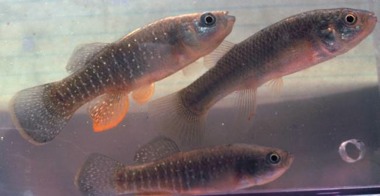Mummichogs are a type of oxygen-breathing fish that flourish in the small pools that form as the tide recedes. But sometimes that pool evaporates or becomes toxic for the fish. So mummichogs have figured out how to move short distances across land in search of the next shallow pool via a series of backward tail flips, propping themselves up between jumps to re-orient themselves.
Cornell University undergraduate Noah Bressman became fascinated with mummichogs while taking a summer course on marine vertebrates at Cornell’s Shoals Marine Lab. One morning he noticed one of the mummichogs on the ground some 3m away from the fish tank. He thought it was odd — shouldn’t a fish that had jumped out of the tank be flopping around just beneath it? — and when he saw another mummichog in the exact same spot the next morning, he decided to investigate the matter as his research project for the course.
Those preliminary results were promising enough to snag a grant so Bressman could return the next summer to complete the research via a series of stranding experiments, recording the fishy behaviour with high-speed video. He just published his results last week in the Journal of Experimental Zoology Part A: Ecological Genetics and Physiology.

“I found out that the fish went to that spot on the floor because it was the spot onto which the first sunlight from the window landed,” Bressman told Gizmodo. “The fish thought that the shiny tiles were actually the surface of water, so they moved towards that spot.”
First the mummichogs will do a tail-flip jump, usually landing on their side. Then they prop themselves into a standing position (if fish can be said to “stand”), roll back onto their side and do another tail jump, repeating the cycle until they reach the water. Bressman thinks that the interim upright position helps the fish orient itself before the next jump. It’s looking for visual cues in the form of reflected light off the surface of water — an hypothesis bolstered by the fact that in dark conditions, the mummichogs showed no preference in moving toward the pool of water.
There were outliers, of course — notably a handful of fish that didn’t move at all, just lay there blowing bubbles to cover their tiny bodies. Bressman said he’s only seen similar behaviour in round gobies, noting a a couple of possible hypotheses to explain it. It could be a way for the fish to ward off drying out, since the bubbles contain liquid and last sufficiently long to buy the mummichog some time to flip its way back to water.
Alternatively, “It could be a byproduct of aerial respiration,” Bressman said. “Since fish don’t typically breathe air, they could coat their respiratory surfaces in a mucous to keep [them] moist to maintain gas exchange. Bubbles could be formed by moving air through this mucous.” Those are merely speculations pending further investigation, however.
Why study the humble mummichog? Certain invasive species, like snakeheads and climbing perch, manage to move from one body of water to another. Studying the mummichogs’ locomotion could shed light on how this is accomplished by other fish, thereby preventing the spread of unwanted species in the future. Bressman says it could also be a useful analogue for how the first vertebrates may have moved from water to land millions of years ago.
Reference:
Bressman, N., Farina, S., and Gibb, A. (2015) “Look before you leap: visual navigation and terrestrial locomotion of the intertidal killifish Fundulus heteroclitus,” Journal of Experimental Zoology Part A: Ecological Genetics and Physiology. Published online, November 5, 2015.
Video courtesy of Noah Bressman. Image: NOAA Photo Library. Public domain.
